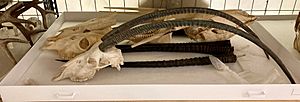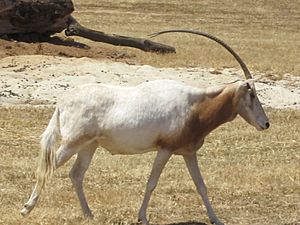Scimitar-horned oryx facts for kids
Quick facts for kids Scimitar oryx |
|
|---|---|
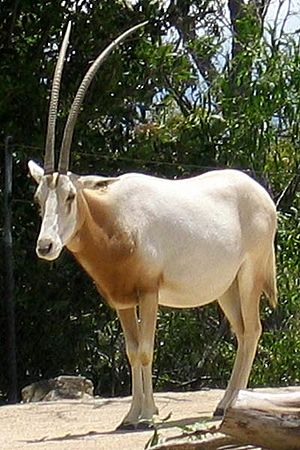 |
|
| Adult at the Taronga Zoo | |
| Conservation status | |
| Scientific classification |
The scimitar oryx (Oryx dammah), also known as the scimitar-horned oryx, is a type of Oryx that used to live all over North Africa. Sadly, in 2000, it was declared extinct in the wild by the IUCN Red List. This means it no longer lived freely in nature.
This amazing oryx is built for tough desert life. It can go for months or even years without drinking water! It eats plants and gets most of its water from them.
The number of scimitar oryxes started to drop because of climate change long ago. Later, people hunted them a lot for their cool horns. Today, they are raised in special places in Tunisia, Morocco, and Senegal. Some are also on private ranches in Texas. In 2016, a plan started to put them back into the wild. Now, a small group lives successfully in Chad.
The scimitar oryx was an important symbol in ancient Egypt. Today, it is the animal symbol for the Sahara Conservation Fund.
Contents
What is a Scimitar Oryx?
The scimitar oryx is a type of antelope with long, curved horns. It belongs to the Oryx group and the Bovidae family, which includes cows and goats.
Its scientific name, Oryx dammah, comes from old words. Oryx means a gazelle or antelope. Dammah comes from words meaning fallow deer or sheep. The name "scimitar oryx" comes from its horns. They look like a scimitar, which is a curved sword.
Scimitar Oryx Body and Look
The scimitar oryx is an antelope with straight horns. It stands a bit over 1 meter (3 feet) tall at the shoulder. Males are bigger than females. Males weigh about 140 to 210 kg (300-460 lbs). Females weigh 91 to 140 kg (200-300 lbs). Their body is 140 to 240 cm (55-94 inches) long. Their tail is 45 to 60 cm (18-24 inches) long with a tuft at the end.
Their fur is white with a reddish-brown chest. They have black marks on their forehead and nose. The white fur helps reflect the sun's heat. The black parts protect them from sunburn. Baby oryxes are born with yellow fur. Their adult colors appear when they are 3 to 12 months old.
Both male and female oryxes have horns. Female horns are thinner. The horns are long, thin, and curve backward. They can be 1.0 to 1.2 meters (3.3-3.9 feet) long. The horns are hollow and can break easily. Their large hooves help them walk on sand. A scimitar oryx can live up to 20 years. One female at the Smithsonian National Zoo lived to be 21, which is very old for an oryx.
How Scimitar Oryxes Live
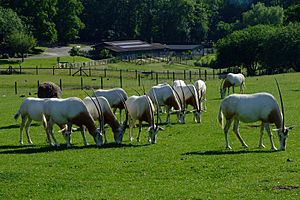
Scimitar oryxes were very social animals. They lived in groups of 2 to 40. A strong male usually led the group. Sometimes, thousands of oryxes would gather to migrate. They would move north into the Sahara during the wet season.
Scimitar oryxes are active during the day. In the cool mornings and evenings, they rest under trees or bushes. If there are no trees, they dig holes in the ground with their hooves to rest. Males often fight, but these fights are usually short and not too rough. Predators like lions, leopards, and hyenas mostly hunt weak or young oryxes.
Amazing Adaptations
Scimitar oryxes have special ways to deal with the desert heat. Their bodies can work well even when it's very hot. This means they don't need to sweat as much to cool down. They can let their body temperature rise to almost 46.5°C (115.7°F) before they start to sweat.
At night, they can lower their body temperature to below 36°C (96.8°F). This gives them more time before they reach their maximum temperature the next day. They can handle heat that would kill most other mammals. They also have a special network of blood vessels that cools blood going to their brain. This keeps their brain safe from overheating.
What Scimitar Oryxes Eat
In the wild, scimitar oryxes lived in grassy areas and deserts. They ate leaves, grass, herbs, shrubs, juicy plants, and fruits. They can live without water for 9-10 months! Their kidneys are very good at saving water.
They get water from plants like wild melon and Indigofera oblongifolia. At night or early morning, they look for plants that collect moisture from the air, like Indigofera colutea. After it rains, they eat grasses like Cymbopogon schoenanthus. In the dry season, they eat seeds from Acacia raddiana and tough grasses like Panicum turgidum.
Reproduction and Life Cycle
Both male and female scimitar oryxes can have babies when they are 18 to 24 months old. Most babies are born between March and October. They have more babies when the weather is good.
When a female is ready to mate, she and a male stand side-by-side, facing opposite ways. Then, they walk in a circle until the female lets the male mate. If she's not ready, she runs away.
Pregnant females leave the group for about a week to give birth. They usually have one baby, which weighs 10 to 15 kg (22-33 lbs). Having twins is very rare. After giving birth, the mother can mate again soon. This means they can have one baby each year. The baby stays with its mother for about nine months. Both mother and baby return to the main group within hours of birth. The mother nurses the calf, and weaning starts at 3.5 months. Young oryxes become fully independent around 14 weeks old.
Where Scimitar Oryxes Lived
The scimitar oryx used to live in grassy areas, semi-deserts, and deserts. This was in a narrow strip across central North Africa, especially in Niger and Chad. They were common on the edge of the Sahara desert, in an area that gets 75 to 150 mm (3-6 inches) of rain each year.
In 1936, a huge group of 10,000 scimitar oryxes was seen in Chad. By the mid-1970s, Chad was home to over 95% of all scimitar oryxes in the world.
Saving the Scimitar Oryx
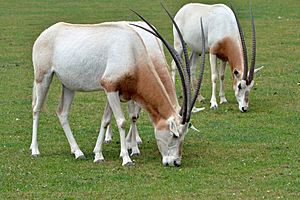
After a wet period called the "green Sahara" ended, the desert became dry. This caused the scimitar oryx population to shrink. Humans also hunted them for their meat and horns. By the 20th century, many were already gone. With horses and guns, hunters could kill them even faster.
The IUCN Red List says the scimitar oryx is "extinct in the wild" since 2000. This means they no longer live freely in nature. Even though people looked for them in Chad and Niger from 2001 to 2004, no wild groups were found.
Bringing Them Back
Now, there's a big program to breed scimitar oryxes in zoos and special reserves. In 2015, about 1,750 oryxes were part of these programs. Many were also kept on farms in Texas and in the Arab states of the Persian Gulf.
Plans are in place to reintroduce them into protected areas. These include parks in Tunisia, Morocco, and Senegal.
Chad is leading a project to bring them back to the Ouadi Rimé-Ouadi Achim Faunal Reserve. This reserve is huge, about the size of Scotland! The first group of 21 oryxes was released in early 2016. By early 2017, they had their first baby in the wild in over 20 years! More groups have been released since then. In 2021, 60 new babies were born, bringing the wild population to about 400.
Zoos like Marwell Zoo and Edinburgh Zoo have also helped. They sent captive-bred oryxes to Tunisia starting in 1985.
Scimitar Oryx in Culture
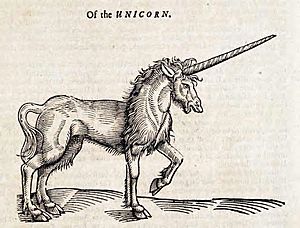
Ancient Times
In ancient Egypt, scimitar oryxes were tamed. They might have been used for religious offerings or as food. The ancient Romans also kept them and ate them. Their hides were very good quality. People used them to make ropes, harnesses, and shields.
The Unicorn Myth
Some people think the myth of the one-horned unicorn came from seeing injured scimitar oryxes. From certain angles, an oryx might look like it has only one horn. If an oryx loses a horn, it won't grow back. So, it would have only one horn for the rest of its life.
See also
 In Spanish: Órix de cuernos de cimitarra para niños
In Spanish: Órix de cuernos de cimitarra para niños



